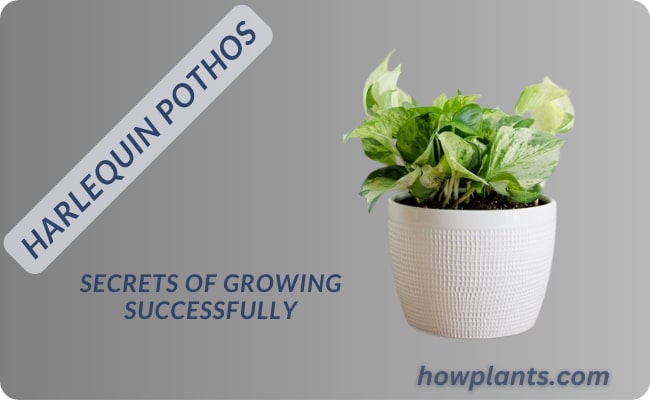Grow beautiful Harlequin Pothos with ease! Get all the information you need to care for and nurture these stunning houseplants.
Harlequin Pothos is an intriguing, unique houseplant. With its dark green and yellow variegated leaves, it provides a stunning display of color, texture and visual interest. In addition to being attractive, Harlequin Pothos is easy to care for and can thrive in almost any environment. This article will provide you with helpful information on how to grow and care for your own Harlequin Pothos so that it can flourish in your home.
What are Harlequin Pothos?
Pothos harlequin is a stunning houseplant that has been gaining popularity in recent years. A member of the Araceae family, this plant is known for its striking variegated leaves that come in shades of green, yellow and white. It’s an easy-to-care-for plant that adds a touch of elegance to any room with its attractive appearance.
One thing that makes Harlequin Pothos unique is its ability to grow both as a trailing vine or as a compact bushy plant. This versatility makes it perfect for hanging baskets or as a tabletop décor item. Additionally, it can thrive in low-light conditions, making it ideal for homes and offices alike.To care for Harlequin Pothos, it’s important to keep its soil slightly moist but not too wet.Caring for harlequin pothos is relatively easy as they are quite low-maintenance plants.
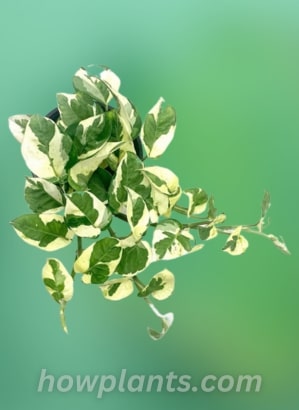
| CHARACTERISTICS | INFORMATION |
|---|---|
| Origin |
|
| Family Name |
|
| Scientific Name |
|
| Other Name |
|
| Shape of Leaves |
|
| Color of Leaves |
|
| Light Requirement |
|
| Soil |
|
| Fertilizer |
|
| Temperature |
|
| pH |
|
| Growth Rate |
|
| Humidity Rate |
|
| Watering Conditions |
|
| Toxicity Status |
|
| Symptoms of Toxicity |
|
| Pests |
|
Origin and Family of Epipremnum Harlequin Pothos
Harlequin Pothos has an interesting origin story, having been first discovered in the Solomon Islands of the South Pacific. It was later introduced to other parts of the world and has since become a favorite among plant enthusiasts. Harlequin pothos plants belong to the Epipremnum genus and are native to Southeast Asia.
The Harlequin Pothos belongs to the family Araceae. This family is known for its diversity in leaf shape and color, as well as its ability to grow both indoors and outdoors. The Harlequin Pothos specifically gets its name from its strikingly patterned leaves, which feature splashes of white, green, and yellow against dark green foliage.
Size of Harlequin Pothos
The harlequin pothos plant is an evergreen climber that can grow up to six feet in length. The size of this plant depends on various factors such as light, water, soil, and temperature. When grown in optimal conditions with bright indirect sunlight and well-draining soil, this plant can grow rapidly and produce large leaves with striking patterns of green and yellow. However, if kept in low light or overwatered soil, it may grow slowly and have smaller leaves with less vibrant colors.
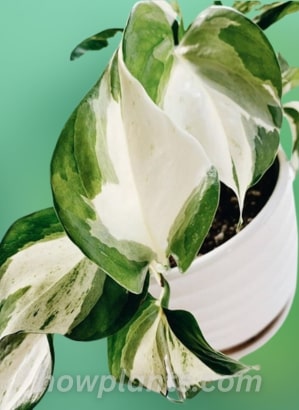
Harlequin Pothos care
Taking care of Harlequin Pothos requires some attention to detail. Firstly, it’s important to note that this plant thrives in bright but indirect light. Direct sunlight may cause damage to the leaves or even burn them. So, it’s best to place the Harlequin Pothos near a window with sheer curtains or blinds for protection against direct sunlight. Additionally, the soil should remain moist but not waterlogged as too much water can lead to root rot which can ultimately be fatal for your plant. Furthermore, like all plants, Harlequin Pothos requires regular pruning in order to maintain its shape and promote growth.
Environmental Conditions for Harlequin Plant
One of the best environmental conditions for harlequin pothos is bright but indirect sunlight. This plant should not be exposed to direct sunlight because it can scorch the leaves and cause them to wilt or turn brown. The ideal location for this plant would be near a window that faces east or west where it can get plenty of natural light without being directly exposed to the sun’s rays. Another critical factor for the growth of harlequin pothos is humidity.
Growth Rate of Harlequin Pothos
In general, Harlequin Pothos is a fast-growing plant that can reach up to six feet long within a few months under the right conditions. If the plant receives bright indirect light with consistent moisture levels, it will grow faster than if it’s exposed to low light or drier soil conditions. Additionally, higher temperatures also enhance faster growth as pothos plants thrive best in warm environments between 70-90°F. However, lower temperatures may cause slower progress in most cases.
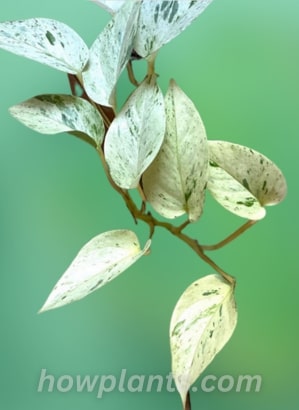
Best Pots for growing Harlequin Pothos
The best pots for growing Harlequin Pothos are those that provide adequate drainage and enough space for the plant’s roots to grow. Terracotta pots are a great option because they allow moisture to evaporate from the soil, preventing root rot. Additionally, terracotta pots offer a rustic aesthetic that complements the green and white hues of Harlequin Pothos leaves. Another excellent choice is ceramic pots. They come in a variety of shapes and sizes which makes it easier for you to find one that fits your home decor style.
When to report your Harlequin Pothos?
One indication that it’s time to repot your harlequin pothos is if you notice roots growing out of the bottom drainage holes. When this happens, it means the plant has outgrown its current container and needs more space for its roots to grow. Additionally, if you notice the soil in the pot becoming compacted or waterlogged, it may be time for a new pot. Another sign that your harlequin pothos needs repotting is if it’s been several years since its last repotting.
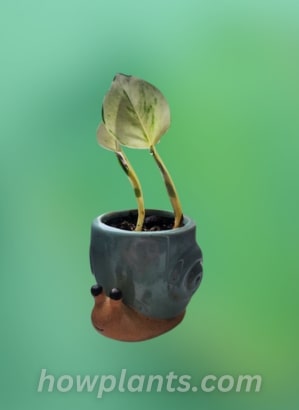
Harlequin Pothos Soil composition
The ideal potting mix for this plant should be made up of equal parts of peat moss, perlite, and vermiculite. The peat moss provides moisture retention and acidity regulation in the soil, while the perlite and vermiculite ensure excellent drainage.
Ideal pH for growth
The ideal pH range for Harlequin Pothos is between 5.5 to 7.5, which is slightly acidic to neutral on the pH scale. When grown in soils with a higher or lower pH, it may affect the plant’s ability to absorb nutrients from the soil efficiently. It’s important to note that harlequin pothos prefers slightly acidic soil with a pH range between 5.5 and 6.5. You can test your soil’s pH level using a simple home testing kit available at most garden centers or online.Signs of mineral deficiency such as yellowing leaves may appear when growing in alkaline soil, while acidic soil can lead to root damage and poor growth.
Ideal Temperature for the growth
Firstly, it’s important to understand that harlequin pothos thrive in warm temperatures between 60°F to 85°F (15°C to 29°C). Temperatures below this range can hinder its growth and cause damage to the plant. Additionally, sudden fluctuations in temperature can stress the plant and lead to issues such as leaf drop or stunted growth.
Cold tolerance of Harlequin Pothos
Harlequin pothos can tolerate temperatures as low as 50°F (10°C) without suffering any damage. However, prolonged exposure to very cold temperatures can harm the plant’s growth and cause leaves to turn yellow or brown. It’s important to note that even though Harlequin pothos can tolerate colder temperatures, it still needs adequate warmth and humidity levels to thrive.
Water Requirements of Harlequin Pothos and when to water
Harlequin pothos grow best in well-draining soil that retains moisture while allowing excess water to drain away. This means that you should be careful not to overwater it as this can lead to root rot and other issues. To determine when your harlequin pothos need watering, check the soil moisture level by inserting your finger about an inch deep into the soil. If it feels dry at this depth, then it’s time to water your plant.
Light Requirements for Harlequin Pothos
First of all, harlequin pothos prefer bright but indirect light. Direct sunlight can scorch its leaves and cause damage. If your plant is placed in a spot where it receives direct sunlight for more than a few hours per day, consider moving it to a shadier location. On the other hand, if the plant doesn’t receive enough light, its foliage may become dull and lose its variegation. If you’re unsure about how much light your harlequin pothos needs, observe the plant’s behavior over time.
Fertilizers that are suitable to enhance the growth and when to give fertilizer
Choosing the right fertilizer for your harlequin pothos is crucial if you want it to flourish. A balanced fertilizer that contains equal amounts of nitrogen (N), phosphorus (P), and potassium (K) is ideal for this plant. You can use either liquid or granular fertilizers, depending on your preference. It’s important to note that too much fertilizer can harm your plant, so be sure to follow the manufacturer’s instructions carefully.
Percentage of Humidity and Aeration is ideal?
When it comes to humidity, harlequin pothos prefer moderate levels ranging from 40-60%. This level of moisture content in the air allows your plant to absorb water through its leaves, promoting healthy growth and preventing dryness. To achieve this optimal range of humidity levels for your pothos plant, you may need to use a humidifier or place a tray of water near it. Additionally, avoid placing your plant near drafty areas like doors or windows as this can cause fluctuations in humidity levels.
How to propagate Harlequin Pothos?
To Progagate Pothos Plants firstly, select a healthy mother plant that has at least 3-4 leaves on it. Then, locate a node on the stem where new growth is present. With clean scissors or pruning shears, cut just below the node at a 45-degree angle. Make sure the cutting is around 4-6 inches long and includes at least one leaf node as well as some attached roots if possible.
Steps of Propagation Harlequin Pothos through stem cutting in Soil
This process involves taking a cutting from the parent plant. Firstly, select a healthy vine from your parent plant that has at least two or three nodes on it. Nodes are the points where leaves emerge from the stem – they’re important because this is where roots will eventually grow from. Using clean pruning shears, make a sharp cut just below the lowest node on your cutting.
Rooting it in moist soil until it develops into a new plant.
Steps of Propagation Harlequin Pothos through stem cutting in Water
Harlequin pothos is a popular houseplant that can add a splash of color to any room. One way to propagate this plant is through stem cuttings in water. Here are the steps you need to follow:
- Choose a healthy stem with at least two leaves and 2-3 nodes.
- Cut the stem just below a node using sharp, clean scissors or pruning shears.
- Remove the bottom leaf from the cutting, leaving one or two leaves at the top.
- Dip the cut end of the stem into rooting hormone powder, if desired, to encourage root growth.
- Fill a clear glass jar or vase with fresh water and place the cutting into it so that only the bottom node is submerged.
- Place the container in bright, indirect light and keep it warm and humid by covering it with plastic wrap.
Steps of Propagating Harlequin Pothos through Air layering Technique
Air layering is one of the most common and effective propagation techniques for harlequin pothos, which involves inducing roots to develop on a stem while it’s still attached to the parent plant. This method allows you to produce an exact clone of your original plant with minimal effort.
- The first step in propagating harlequin pothos through air layering technique is selecting a healthy stem that you want to propagate. Make sure that it has two or three healthy leaves and there are no signs of disease or pests.
- Next, identify the point where you want roots to emerge and make a small cut about 1/3 of the way into the stem using a sharp knife or scissors.
- Then, gently peel back the bark from around the cut area until you expose some fresh wood underneath.
Steps of Propagating Harlequin Plant through Division Technique
Propagating this plant through division technique is a simple process that requires minimal effort and investment.
- The first step of propagating Harlequin Pothos through division technique is to prepare the mother plant by watering it thoroughly a day before dividing it. This helps ensure that the roots are hydrated and healthy, making them easier to divide.
- Secondly, remove the mother plant from its pot and gently shake off any excess soil around the roots. This will help expose the root ball for better visibility while dividing.
Harlequin Pothos’s Flowers size, Shape and When they grow?
One of the most notable characteristics of Harlequin pothos is their variegated leaves that display a mix of green, white, and yellow colors in irregular patterns. The leaves have a heart-shaped appearance with pointed tips that can grow up to 4-6 inches long.
When it comes to the size of Harlequin pothos flowers, they are relatively small and inconspicuous compared to the size of its leaves. The flowers usually appear during the growing season in early summer or late spring when conditions are optimal for growth. You may not even notice them since they tend to be hidden behind the foliage.

Toxicity Atatus of Pothos Plant
According to the American Society for the Prevention of Cruelty to Animals (ASPCA), harlequin pothos contain calcium oxalate crystals that can cause irritation in the mouth, throat, and stomach if ingested. These crystals are also found in other common houseplants such as philodendrons and peace lilies. While not typically fatal, ingestion of these plants can cause discomfort and vomiting in pets. It’s important for pet owners and parents with small children to be aware of the potential risks associated with harlequin pothos.
Pest that can Attack Harlequin
There are several pests that can attack Harlequin Pothos, including mealybugs, spider mites, and aphids.
Fungus Gnats
Fungus gnats are tiny flies that may seem harmless at first, but they can cause significant damage to indoor plants like harlequin pothos. These pests lay their eggs in moist soil, which then hatch into larvae that feed on the plant’s roots. In addition to weakening the plant’s structure, fungus gnats can also introduce harmful fungi and diseases that further harm your beloved houseplant.
One of the most severe consequences of a fungus gnat infestation is the emergence of “fungus giants.” These massive fungal growths thrive in damp conditions and can quickly take over your plant’s root system. As these giants grow larger, they can cause extensive damage to your harlequin pothos’ root network, leading to nutrient deficiencies and stunted growth.
White Flies
White flies are tiny pests that can cause big problems for houseplants. They are common in warm, humid environments and often attack plants such as the harlequin pothos. These small insects feed on the sap of plants, causing yellowing leaves and stunted growth. If left unchecked, infestations can quickly spread to other plants in your home.
If you suspect your harlequin pothos has been attacked by white flies, there are several steps you can take to get rid of them. The first step is to isolate the plant from others in your home to prevent further spread of the pests. You can then use a combination of insecticidal soap or neem oil spray and sticky traps to eradicate the infestation. It’s also important to regularly inspect your plants for signs of white fly activity and remove any infected leaves immediately.
Mealy Bugs
Mealybugs are tiny and soft-bodied insects that invade houseplants, including the harlequin pothos. These bugs are difficult to see because they hide in crevices and produce a fluffy wax coating on their bodies. They feed on plant sap, stunting growth and causing leaves to yellow or drop.
If you notice mealybugs infesting your harlequin pothos, it’s essential to take immediate action. The first step is to isolate the affected plant from other houseplants to prevent the spread of infestation. Next, inspect every part of the plant for signs of mealybug clusters, which typically appear as small white cottony patches on stems or leaves.
Root Rot
Root rot is a serious condition that can affect many types of plants, including the harlequin pothos. This disease is caused by a fungus that attacks the roots of the plant, causing them to decay and eventually die. When this happens, it becomes difficult for the plant to absorb nutrients and water from the soil, leading to wilting and eventual death.
If your harlequin pothos is affected by root rot, you may notice yellowing leaves or stunted growth. In some cases, you may also see blackened or mushy roots when you inspect the plant’s root system. If left untreated, root rot can quickly spread throughout your plant collection and cause significant damage. To prevent root rot in your harlequin pothos, it is important to ensure that its soil has good drainage and that you are not overwatering it.
Other Problems related to Harlequin Pothos
Harlequin pothos is a hardy plant that is well-known for its beauty and easy care. However, like any other houseplant, harlequin pothos can experience problems if not properly maintained.
Leaves Drooping
Many plant owners have experienced the frustrating issue of its leaves drooping. There are several reasons why this may occur. Firstly, if the soil is too dry or waterlogged with poor drainage, it can cause the plant to become stressed and result in drooping leaves. Secondly, if the pothos is placed in an area with too much direct sunlight or too little light altogether, it could lead to leaf drooping as well. Another reason for leaf drooping could be due to pests such as spider mites or mealybugs that can damage the foliage and make them wilt.
Firstly, overwatering is one of the most common reasons for leaf drooping in harlequin pothos. When plants receive excess water, their roots become waterlogged, leading to oxygen deprivation and root rot. This can cause the leaves to droop and eventually fall off. Secondly, underwatering can also result in leaf drooping in harlequin pothos. When plants do not receive enough water or moisture from their soil or growing medium, they tend to conserve water by wilting their leaves.
Yellowing of Leaves
The primary reason for the yellowing of leaves is overwatering. When the plant receives more water than it needs, its roots become saturated, which results in the yellowing of leaves. Another reason for the yellowing of harlequin pothos leaves could be inadequate lighting conditions. This plant thrives well in moderate to bright light but can get stressed if exposed to direct sunlight or kept in a dark corner with no access to natural light. Lack of proper fertilization can also cause leaf yellowing as it deprives the plant of essential nutrients needed for healthy growth.
Brown Tips
One reason why the tips of Harlequin Pothos leaves turn brown is due to underwatering. When the plant doesn’t receive enough water, its foliage will start to wilt and dry out. Another cause could be overfertilizing your plant – too much fertilizer can accumulate in the soil and damage the roots, leading to browning at the tips of the leaves.
Rarest Pothos
Pothos, also known as Devil’s Ivy, is one of the most popular indoor plants due to its low maintenance and beautiful appearance. There are many Varieties of Pothos, some more common than others. However, there are a few rare pothos that plant enthusiasts covet.
One such rare pothos is Variegated Neon Pothos. This plant has vibrant lime green leaves with bright yellow variegation that adds a pop of color to any space. It is not easy to find this variety because it takes longer to grow and requires specific environmental conditions. The Variegated Neon Pothos can be quite expensive due to its rarity.
Another coveted rarity is the Marble Queen Pothos. The Marble Queen Pothos has stunning white and green marbled leaves that make for an eye-catching addition to any room.

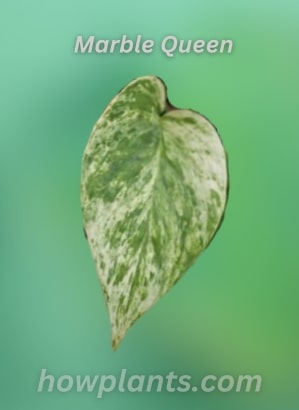
Harlequin Pothos VS Manjula Pothos
Two popular varieties of Pothos that often get compared are Harlequin Pothos and Manjula Pothos. The Harlequin variety has strikingly unique leaves, featuring splashes of white, green, and yellow that resemble a harlequin costume. In contrast, the Manjula variety has more delicate foliage with creamy white edges and green centers.
One key difference between these two varieties is their growth pattern.
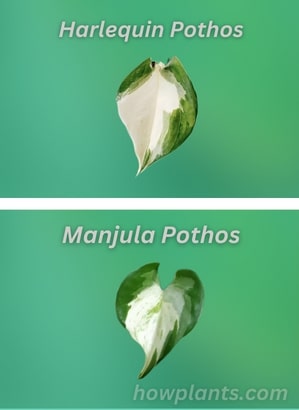
Conclusion
In conclusion,the Harlequin Pothos is a beautiful and interesting houseplant that can bring life and color to any room. One of the most fascinating things about harlequin pothos is its ability to purify the air in your home. Studies have shown that this hardy plant can remove harmful chemicals such as benzene, formaldehyde, and carbon monoxide from the air. As a result, it is considered an ideal plant for those who suffer from allergies or asthma. It’s easy to care for, doesn’t need much light or water, and is an ideal choice for those who don’t have a green thumb. If you want to improve the look of your home with a unique, eye-catching plant, then why not consider the Harlequin Pothos?
